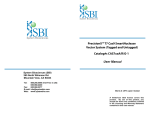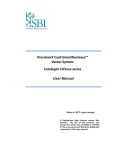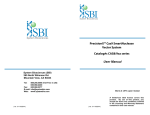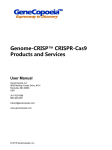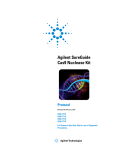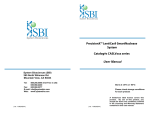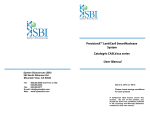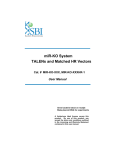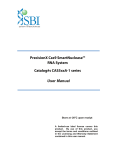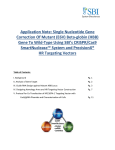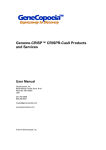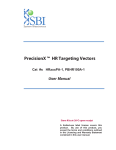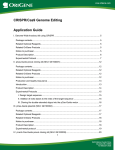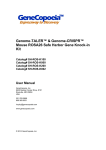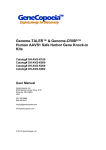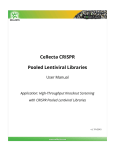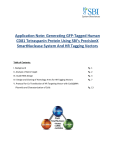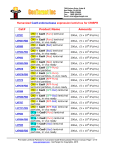Download User Manual - System Biosciences
Transcript
PrecisionX™ Cas9 Combo Kit Catalog#s CAS7xxA/R/G-KIT User Manual System Biosciences (SBI) 265 North Whisman Rd. Mountain View, CA 94043 Tel: 888.266.5066 (Toll Free in US) 650.968.2200 Fax: 650.968.2277 E-mail: [email protected] Web: www.systembio.com Store at -20°C upon receipt A limited-use label license covers this product. By use of this product, you accept the terms and conditions outlined in the Licensing and Warranty Statement contained in this user manual. PrecisionX™ Cas9 Combo Kit Cat. # CAS7xxA/R/G-KIT Contents I. Introduction ..............................................................................2 A. Overview of CRISPR system ..................................................2 B. Product Information and Vector Maps ....................................5 C. Key Features of the Cas9 Combo Kit .....................................8 D. Overview of Cas9 Combo Kit Workflow..................................9 E. List of Components ...............................................................11 F. Additional Materials Required ...............................................13 G. Related Products ..................................................................13 H. Shipping and Storage Conditions for Kit ...............................14 II. Validation Data for Cas9 Combo Kit ......................................14 A. Gene repair by double-nicking and HR .............................14 B. Gene Knockout by dual gRNAs targeting RFP .................15 C. Tandem paired-nicking (4 gRNAs in nickase vector) ........16 III. Single gRNA Cloning Protocol using Cas9 Combo Kit........................17 A. Quick Overview of the Protocol ............................................17 B. Selection of Target DNA Sequence ......................................18 C. Design of Guide RNA Oligonucleotides ................................19 D. Cloning into the Linearized Cas9 SmartNuclease™ Vector .20 E. Transfection of the Cas9 SmartNuclease™ Construct into Target Cells ...............................................................................22 IV. Multiple gRNA Cloning Protocol using Cas9 Combo Kit ......................23 A. Design of Primers for PCR reaction (For Dual gRNA cloning) 23 888-266-5066 (Toll Free) 650-968-2200 (outside US) Page 1 System Biosciences (SBI) User Manual B. Design of Primers for PCR reaction (For “Quad-Plex” gRNA cloning) ......................................................................................24 C. Setting up the PCR Reaction ................................................27 D. Fusion Reaction ...................................................................29 E. Transformation of Cells ........................................................30 F. Confirmation of Positive Clones ...........................................30 G. Transfection of the Cas9 SmartNuclease™ Construct into Target Cells ...............................................................................32 V. Frequently Asked Questions ..............................................33 VI. Appendix ............................................................................35 A. Primer design for dual gRNA/single promoter constructs ..............................................................................35 I. VII. References .........................................................................36 VIII. Technical Support ..............................................................38 IX. Licensing and Warranty information ..................................38 Introduction A. Overview of CRISPR system In the past decade, a great deal of progress has been made in the field of targeted genome engineering. Technologies such as designer zinc finger nucleases (ZFNs), transcriptional activator-like effector nucleases (TALENs), and homing meganucleases have made site-specific genome modifications a reality in many different model organisms ranging from zebrafish to mammalian cells. Based on the results to date, however, genome editing tools that are efficient, flexible, and cost-effective have remained elusive to the general research community. The recent discovery of the type II prokaryotic CRISPR (Clustered Regularly Interspaced Short Page 2 ver. 1-150109 www.systembio.com PrecisionX™ Cas9 Combo Kit Cat. # CAS7xxA/R/G-KIT Palindromic Repeats) system, originally discovered in the bacterium Streptococcus pyogenes as a mechanism to defend against viruses and foreign DNA, has provided yet another tool for targeted genome engineering, this time taking advantage of a system that uses small RNAs as guides to cleave DNA in a sequence-specific manner. With its ease in designing guide sequences to target specific sequences (unlike ZFNs and TALENs where construct assembly can be laborious and time-consuming), as well as its targeting efficiency, this system has the potential to be a disruptive technology in the field of genome-engineering. The CRISPR/CRISPR-associated (Cas) system involves 1) retention of foreign genetic material, called “spacers”, in clustered arrays in the host genome, 2) expression of short guiding RNAs (crRNAs) from the spacers, 3) binding of the crRNAs to specific portions of the foreign DNA called protospacers and 4) degradation of protospacers by CRISPR-associated nucleases (Cas). A well-characterized Type II CRISPR system has been previously described in the bacterium Streptococcus pyogenes, where four genes (Cas9, Cas1, Cas2, Csn1) and two non-coding small RNAs (pre-crRNA and tracrRNA) act in concert to target and degrade foreign DNA in a sequence-specific manner [Jinek et. al. 2012]. The specificity of binding to the foreign DNA is controlled by the non-repetitive spacer elements in the pre-crRNA, which upon transcription along with the tracrRNA, directs the Cas9 nuclease to the protospacer:crRNA heteroduplex and induces double-strand breakage (DSB) formation. Additionally, the Cas9 nuclease cuts the DNA only if a specific sequence known as protospacer adjacent motif (PAM) is present immediately downstream of the protospacer sequence, whose canonical sequence in S. pyogenes is 5’ - NGG -3’, where N refers to any nucleotide. 888-266-5066 (Toll Free) 650-968-2200 (outside US) Page 3 System Biosciences (SBI) User Manual Figure 1: Overview of the CRISPR system. Figure adapted from Cong et al. “Multiplex Genome Engineering Using CRISPR/Cas Systems”. Recently, it has been demonstrated that the expression of a single chimeric crRNA:tracrRNA transcript, which normally is expressed as two different RNAs in the native type II CRISPR system, is sufficient to direct the Cas9 nuclease to sequence-specifically cleave target DNA sequences. By adapting the endogenous type II CRISPR/Cas system in S. pyogenes for utility in mammalian cells, several groups have independently shown that RNA-guided Cas9 is able to efficiently introduce precise double stranded breaks at endogenous genomic loci in mammalian cells with high efficiencies and minimal off-target effects [Cong et al. 2013, Mali et al. 2013, Cho et al. 2013]. Page 4 ver. 1-150109 www.systembio.com PrecisionX™ Cas9 Combo Kit Cat. # CAS7xxA/R/G-KIT In addition, several mutant forms of Cas9 nuclease have been developed to take advantage of their features for additional applications in genome engineering and transcriptional regulation Biochemical characterization of a mutant form of Cas9 nuclease (D10A) functions as a nickase (Jinek et al. 2012), generating a break in the complementary strand of DNA rather than both strands as with the wild-type Cas9. This allows repair of the DNA template using a high-fidelity pathway rather than NHEJ, which prevents formation of indels at the targeted locus, and possibly other locations in the genome to reduce possible off-target/toxicity effects while maintaining ability to undergo homologous recombination (Cong et al. 2013). Recently, paired nicking has been shown to reduce off-target activity by 50- to 1,500 fold in cell lines and to facilitate gene knockout in mouse zygote without losing on-target cleavage efficiency (Ran et al., 2013). Finally, tandem knockout of both RuvCI and HNH nuclease domains (which control cutting of the DNA strands) shows that the nullnuclease mutant (double mutant) can act as a transcriptional repressor (Qi et al. 2013) with minimal off-target effects, which leads to possibilities for studying site-specific transcriptional regulation. Taken together, the RNA-guided Cas9 system defines a new class of genome engineering tools, creating new opportunities for research across basic sciences, biotechnology and biomedicine. B. Product Information and Vector Maps The Cas9 Combo Kit (see Table 1) contains a prelinearized CAS7xx series vector as well SBI’s innovative Multiplex gRNA Cloning Kit (Cat #CAS9-GRNA-KIT). This kit is specially designed for rapid and efficient cloning of single or multiple gRNAs in a single vector under the control of Pol-III promoters such as H1 and U6. The Combo Kit is based on SBI’s proven restriction enzyme and ligase-free Cold Fusion technology. This revolutionary combo format provides researchers with a complete, “one-stop” solution 888-266-5066 (Toll Free) 650-968-2200 (outside US) Page 5 System Biosciences (SBI) User Manual for genome engineering applications requiring expression of multiple gRNAs. Note: The table below shows information for combo kits containing untagged Cas9/nickase vectors. Combo kits containing GFP/RFP-tagged vectors can be ordered by placing “-KIT” after the catalog number (e.g. CAS700G-KIT, CAS701R-KIT, etc.). Please refer to the list of tagged vectors in Table 2 of the PrecisionX™ T7-based Cas9 SmartNuclease/Nickase System User manual (http://www.systembio.com/downloads/Tagged-Cas9SmartNuclease-user-manual.pdf) Detailed protocol information for cloning of multiple gRNAs using the untagged vectors can be found in Section IV of this user manual as well as the Appendix (Section VI), which contains additional protocols for customers desiring the use of the same promoter for driving multiple gRNAs. Table 1. List of combo kits containing all-in-one Cas9 SmartNuclease™ and Nickase Vectors with Multiplex gRNA Cloning Kit Cat# CAS700A-KIT CAS720A-KIT CAS740A-KIT CAS750A-KIT CAS770A-KIT Page 6 Description Size Multiple gRNA Kit + EF1-T7-hspCas9H1-gRNA linearized SmartNuclease vector Multiple gRNA Kit + CAG-T7-hspCas9H1-gRNA linearized SmartNuclease vector Multiple gRNA Kit + CMV-T7-hspCas9H1-gRNA linearized SmartNuclease vector Multiple gRNA Kit + EF1-T7-Cas9 nickase-H1-gRNA linearized SmartNuclease vector Multiple gRNA Kit + CAG-T7-Cas9 nickase-H1-gRNA linearized SmartNuclease vector ver. 1-150109 10 rxn 10 rxn 10 rxn 10 rxn 10 rxn www.systembio.com PrecisionX™ Cas9 Combo Kit Cat. # CAS7xxA/R/G-KIT CAS790A-KIT Multiple gRNA Kit + CMV-T7-Cas9 nickase-H1-gRNA linearized SmartNuclease vector 10 rxn Note: For CAS7XXG-KIT and CAS7XXR-KIT formats, the same protocol as CAS7XXA-KIT applies (see Section III and IV) Selected Cas9 SmartNuclease Constructs 888-266-5066 (Toll Free) 650-968-2200 (outside US) Page 7 System Biosciences (SBI) User Manual In addition to EF1a, CMV and CAG versions of the Cas9 SmartNuclease and Nickase vectors are also available Fig. 2: Vector maps of Cas9 SmartNuclease Expression Vectors with T7 promoter C. Key Features of the Cas9 Combo Kit The Cas9 Combo Kit provides the following advantages to the researcher: Saves time and reagents - No need to clone separate constructs bearing different gRNAs Simple PCR and “fusion” reaction to generate multicistronic constructs Ideal for Cas9 nickase applications requiring expression of two gRNAs simultaneously for precise targeting Single plasmid system reduces transfection variability associated with multi-plasmid transfection Facilitates the use of more advanced Cas9 targeting applications, including tandem gRNA cutting and tandem double-nicking Enables precise deletion of defined genomic segments with a single vector Page 8 ver. 1-150109 www.systembio.com PrecisionX™ Cas9 Combo Kit Cat. # CAS7xxA/R/G-KIT The Multiplex gRNA Cloning components in the Cas9 Combo Kit is based on SBI’s proven Cold Fusion cloning technology, which has been the standard for restriction and ligase-free cloning technology for many years, freeing customers from laborious and time-consuming traditional cloning approaches. D. Overview of Cas9 Combo Kit Workflow Introducing single gRNA cassette into CAS7xx vector Fig. 3: General Workflow of Cas9 Combo Kit to clone single gRNA into Cas9 SmartNuclease/Nickase Expression System. 888-266-5066 (Toll Free) 650-968-2200 (outside US) Page 9 System Biosciences (SBI) User Manual Introducing multiple (e.g. dual gRNA) cassettes into CAS7xx vector Fig. 4: General workflow using Cas9 Combo Kit to clone multiple (e.g. dual gRNA) cassettes into CAS7xx vector The multiplex cloning reaction involves two steps: Step 1: Overlapping PCR of the two primers (designed by the user) with a scaffold-promoter block (provided in the kit) to create a PCR product containing the desired amplicon containing both gRNAs. Step 2: Using the PCR amplicon created in Step 1, fuse the fragment into linearized destination vector. Page 10 ver. 1-150109 www.systembio.com PrecisionX™ Cas9 Combo Kit Cat. # CAS7xxA/R/G-KIT This cloning process is extremely efficient, and has been demonstrated to be useful in applications such as targeting noncoding RNAs (Ho et al. 2014). In addition, the kit can be adapted to more than two gRNAs in single reaction. SBI has validated the cloning and fusion of 4 separate guide RNAs (Fig. 5 below) in a simple PCR and fusion reaction into a linearized destination vector. The level of flexibility, ease of use, and efficiency of the Cas9 Combo Kit is an industry-first – designed with the researcher in mind who needs freedom from limitations imposed by traditional gRNA cloning methods. Fig. 5: Example diagram of generating a “quad-plex” multi-gRNA cassette using the Cas9 Combo Kit E. List of Components The Cas9 Combo Kit contains enough reagents to perform up to 10 single or multiple gRNA cloning reactions in an easy-to-use 888-266-5066 (Toll Free) 650-968-2200 (outside US) Page 11 System Biosciences (SBI) User Manual format (Table 2). All of the components necessary for cloning single or multi-gRNA into the Cas9 vector are provided in the kit. Note: Reagents for PCR amplification are not included Table 2. List of components included in the Cas9 Combo Kit Reagent Amount Linearized CAS7xx Vector 10 µl 5x ligation buffer 10 µl Fast ligase 2.5 µl 5X Master Mix 20 µl Linearized vector (positive control) 5 µl PCR product (positive control) 5 µl H1 Block 5 µl U6 Block 5 µl H1 Fwd Sequencing primer 5’ GTCATCAACCCGCTCCAAGG 3' 20 µl GRNA-PR-F 5’ GACGAGTCGGATCTCCCTTTG 3’ 50 µl GRNA-PR-R 5’ CAAGTTCCTCTCACTCTCTGA 3’ 50 µl Additional GRNA-PR-F/R primers can be ordered from SBI (Cat # CAS9-GRNA-PR) Page 12 ver. 1-150109 www.systembio.com PrecisionX™ Cas9 Combo Kit Cat. # CAS7xxA/R/G-KIT F. Additional Materials Required For single gRNA cloning: 1) LB Agar and Broth containing 50µg/ml Kanamycin 2) Any high-transformation efficiency E.coli competent cells TM 3) Zyppy Plasmid MiniPrep Kit (Zymo Research, Cat. # D4019) 4) Qiagen EndoFree Plasmid Maxi Kit (Qiagen, Cat. # 12362) 5) PureFection Transfection Reagent (System Biosciences, Cat #LV750A-1) or equivalent For multiple gRNA cloning: In addition to the reagents above, the following components are required: 1) Vector/gRNA-specific primers (standard desalted, nonphosphorylated oligos) 2) dNTPs, Phusion (recommended) or other high fidelity polymerase, and corresponding buffers for PCR 3) PCR-Grade Dimethyl Sulfoxide (Cat #D9170, Sigma) 4) QIAquick PCR Purification Kit (Cat # 28106, Qiagen) 5) QIAquick Gel Extraction kit (Cat # 28704, Qiagen) G. Related Products 1) Multiplex gRNA Cloning Kit (Cat #CAS9-GRNA-KIT) 2) SBI offers a number of Homologous Recombination (HR) Donor Vectors, including the popular PrecisionX HR Targeting Vectors (Cat #HR1xxPA-1) for generating gene knockouts and knockins, as well as the piggyBac HR Donor for seamless excision of selection cassette (Cat# PBHR100A-1). The full selection of HR Donor vectors may be viewed on the following webpage: 888-266-5066 (Toll Free) 650-968-2200 (outside US) Page 13 System Biosciences (SBI) User Manual http://www.systembio.com/genome-engineering-precisionx-HRvectors/ordering. H. Shipping and Storage Conditions for Kit PrecisionX™ Cas9 Combo Kits are shipped on blue ice. Upon receiving, store the kit at -20°C. Shelf life of the product is 1 year after receipt if stored in -20°C. II. Validation Data for Cas9 Combo Kit A. Gene repair by double-nicking and HR Fig. 6: Functional validation of dual gRNAs generated by the Cas9 Combo Kit for combined double-nickase and homologous Page 14 ver. 1-150109 www.systembio.com PrecisionX™ Cas9 Combo Kit Cat. # CAS7xxA/R/G-KIT recombination to rescue EGFP in the EGIP control cell line. (EGIP cell line courtesy of Dr. Jizhong Zou, NIH CRM.) B. Gene Knockout by dual gRNAs targeting RFP 888-266-5066 (Toll Free) 650-968-2200 (outside US) Page 15 System Biosciences (SBI) User Manual Fig. 7: Functional validation of dual gRNAs cloned into SBI’s CAS940A-1 vector (CMV-hspCas9-H1-gRNA) using the Cas9 Combo Kit to target RFP in a cell line stably expressing a CMVGFP-T2A-RFP cassette. PCR assay with primers flanking RFP indicate evidence of cutting by gRNAs, and fluorescence images of targeted cells vs control show reduction in RFP expression. C. Tandem paired-nicking (4 gRNAs in nickase vector) Page 16 ver. 1-150109 www.systembio.com PrecisionX™ Cas9 Combo Kit Cat. # CAS7xxA/R/G-KIT Fig. 8: Functional validation of “quad-plex” gRNAs cloned into CAS800A-1 nickase vector (EF1-Nickase-H1-gRNA) using the Cas9 Combo Kit for targeting GFP and RFP in a cell line stably expressing a CMV-GFP-T2A-RFP cassette. PCR assay with primers (one at 5’ end of GFP and other at 3’ end of RFP) indicate evidence of cutting by gRNAs. Fluorescence images of targeted cells vs control show significant reduction in both RFP and GFP expression. III. Single gRNA Cloning Protocol using Cas9 Combo Kit A. Quick Overview of the Protocol The general workflow of the cloning, validation, and transfection of the single gRNA into Cas9 SmartNuclease/Nickase expression constructs using the Cas9 Combo Kit is depicted in Fig. 3. Briefly, here are the steps involved in the process: 1) Design two DNA oligonucleotides that are sense and antisense sequences of the target DNA which is 20bp upstream of the PAM (5’ - NGG - 3’) 2) Anneal the two oligonucleotides to generate a duplex 3) Clone the duplex into the provided linearized Cas9 vector by ligation reaction 4) Transform into competent cells and grow in LB/ Kanamycin plate (50 µg/ml) 5) Confirm positive clones by direct sequencing 888-266-5066 (Toll Free) 650-968-2200 (outside US) Page 17 System Biosciences (SBI) User Manual 6) Transfect sequence-verified all-in-one construct into mammalian cells using standard transfection protocols 7) Sort transfected cells by standard FACS sorting, and perform Surveyor Nuclease assay (or other suitable mismatch cleavage assays) to check the site-specific genome cleavage, or perform homology recombination assays for genome modification using a suitable donor vector. B. Selection of Target DNA Sequence The selection of the target DNA sequence is not limited by any constraints, with exception of a PAM sequence in the form of 5’ NGG - 3’ (where N = any base) immediately following the target sequence. The typical length of the target sequence is 20bp – as shown here: 5’ NNNNNNNNNNNNNNNNNNNNNGG 3’ In order to enhance genome editing specificity, paired gRNA with Cas9 Nickase constructs can be used to generate double nicking with 5’ overhangs. Please follow the guideline below for paired gRNA selection and design. 3’ Targeting site gRNA 1 TAGCCGTAACGAATGGCAAT -5’ ATCGGCATTGCTTACCGTTA CCN 5’ 3’ GGN CGTAAGCTTACGCGATGCAC NGG Cas9 (D10A) Nickase Cas9 (D10A) Nickase GCATTCGAATGCGCTACGTG TAGCCGTAACGAATGGCAAT 3’ 5’ NCC 5’- CGTAAGCTTACGCGATGCAC gRNA 2 3’ 5’ 3’ 3’ 5’ 5’ overhang Choose your gRNA1 from the anti-sense strand upstream of your targeting site Choose your gRNA2 from the sense strand downstream of your targeting site Page 18 ver. 1-150109 www.systembio.com PrecisionX™ Cas9 Combo Kit Cat. # CAS7xxA/R/G-KIT Fig. 9: Schematic illustration of generating 5’ overhang double strand DNA breaks using paired gRNAs with Cas9 Nickase (adapted from Ran et. al. 2013) Please note that only gRNA pairs creating 5’ overhangs with less than 8bp overlap between the guide sequences were able to mediate detectable indel formation (Ran et al. 2013). To achieve high cleavage efficiency using Cas9 Nickase with paired gRNAs, make sure each gRNA is able to efficiently induce indels when coupled with wild-type Cas9. C. Design of Guide RNA Oligonucleotides Design two DNA oligonucleotides (a top strand and a bottom strand) according to the following structure shown below. 5’ ATCCNNNNNNNNNNNNNNNNNNNN 3’ 3’ NNNNNNNNNNNNNNNNNNNNCAAA 5’ The top strand has an ATCC overhang at its 5’end, followed by the selected target sequence. The bottom strand has an AAAC overhang at its 5’ end followed by a target sequence complementary to the top strand. Example: If your target sequence is AGCGAGGCTAGCGACAGCATAGG (AGG = PAM sequence), then the oligo sequences would be: Top strand oligo: 5’ – ATCCAGCGAGGCTAGCGACAGCAT - 3’ Bottom strand oligo: 5’ – AAACATGCTGTCGCTAGCCTCGCT - 3’ 888-266-5066 (Toll Free) 650-968-2200 (outside US) Page 19 System Biosciences (SBI) User Manual D. Cloning into the SmartNuclease™ Vector Linearized Cas9 1) Anneal the two single-strand DNA oligonucleotides: Dilute your stock primers to 10uM using 1x Annealing Buffer (10mM Tris pH7.5, 50mM NaCl, 1mM EDTA) and set up the annealing reaction as follows: Materials Amount 10uM Top strand oligo 10uM Bottom strand oligo Total volume 5 µl 5 µl 10 µl Incubate reaction mixture at 95°C for 5 minutes (can be done in PCR machine). Remove the tube and leave it on bench at room temperature to cool down to RT. Alternatively, you can set a thermocycler program to cool down the oligos at a rate of 1°C/min (will take ~40min to 60min to complete). 2) Ligation of Oligo Duplex into Vector Since the tubes might be placed upside down during the shipping, and some of reagents may end up at the top of tubes, we recommend a brief spin to bring all the reagents down to the bottom of tubes before opening the tubes. Note: Due to the sensitivity of the vectors to repeated freeze- thaw cycles, please store the vectors at 4C for short-term usage or aliquot to individual tubes for longterm storage. Page 20 ver. 1-150109 www.systembio.com PrecisionX™ Cas9 Combo Kit Cat. # CAS7xxA/R/G-KIT Set up the ligation reaction as follows: Materials Amounts Linearized vector Annealed oligo mix 5x ligation buffer Fast ligase Total volume 1 µl 3 µl 1 µl 0.25 µl 5.25 µl Mix reaction well and incubate for 5-7 minutes at room temperature If you are making several constructs at the same time, we strongly recommend adding ligase and buffer separately and individually to the linearized vector (i.e., do not make and aliquot a pre-mixture of ligase and buffer to the linearized vector). 3) Transformation Reaction a. Add a vial of competent cells to the ligation mix b. Place cells on ice for 15 minutes c. Heatshock cells at 42°C for 50 seconds, then immediately transfer cells to ice for 2 minutes d. Add 250 µl SOC medium and incubate at 37°C for 1 hour with shaking e. Spread 100 µl of cultured cells on a pre-warmed LB plate containing 50 µg/ml Kanamycin and incubate overnight at 37°C 4) Confirmation of Positive Clones 888-266-5066 (Toll Free) 650-968-2200 (outside US) Page 21 System Biosciences (SBI) User Manual a. Pick 1 to 2 colonies, grow in LB/Kanamycin medium overnight at 37°C with shaking b. Next day, miniprep plasmid DNAs and send for sequencing using the provided sequencing primer (Note: Primer provided is ready to use, concentrated at 5 µM, simply use 1 µl per reaction) c. Align your raw sequencing data with the top strand primer sequence. E. Transfection of the Cas9 SmartNuclease™ Construct into Target Cells 1) Plate 100,000 to 200,000 of target cells (e.g. 293T cells) into a single well of a 12-well plate in 1 ml of appropriate growth medium. Include a single well of cells as negative control (which can be non-relevant plasmid DNA or linearized Cas9 SmartNuclease plasmid DNA) as well as replicate wells for additional analysis (see Step 4) 2) Next day, or when cells are 50-60% confluent, transfect target cells with the Cas9 SmartNuclease vector (and donor vector if HDR is desired) using a suitable transfection reagent following the manufacturer’s recommended protocol. The use of reduced or serumfree media containing no antibiotics to dilute the vector/transfection complex is highly recommended. Note: For 293T cells, we transfected 0.5 µg of the Cas9 SmartNuclease vector into cells for cleavage of gene targets and used a 1:1 ratio of Cas9 SmartNuclease vector (0.5 µg) and HR donor vector (0.5 µg) for HDR applications. In general, we suggest optimizing the amounts and ratios of Cas9 SmartNuclease and donor vectors for optimal results in a target cell line. 3) Allow at least 12 hours before changing transfection media to complete growth media Page 22 ver. 1-150109 www.systembio.com PrecisionX™ Cas9 Combo Kit Cat. # CAS7xxA/R/G-KIT 4) After 48-72 hrs post-transfection, sort GFP or RFP positive cells using a fluorescence-activated cell sorter (FACS) per standard sorting parameters. We recommend a minimum of 25,000 to 50,000 positive events for subsequent subculturing of cells. Assay for cleavage activity in sorted cells using Surveyor Nuclease Assay, mutation characterization by genotyping analysis, or HDR activity (if using donor vector in parallel) of sorted cells Note: If assaying for HDR of donor vector in RFP or GFP-sorted cells, please subculture the sorted cells and select for cells that have undergone HR using an antibiotic selection marker present in the HR donor vector. The optimal concentration of antibiotic for the targeted cell line must be determined empirically by a kill curve assay. IV. Multiple gRNA Cloning Protocol using Cas9 Combo Kit A. Design of Primers for PCR reaction (For Dual gRNA cloning) Prior to the experiment, complete forward and reverse primers for generating the desired multiplex gRNA PCR amplicon will need to be designed. Once the correct sized amplicon is generated and gel-purified, it can be used as the insert in the subsequent fusion reaction with a suitable linearized destination vector. The general format of the PCR primers for the Cas9 Combo Kit is shown below for generating constructs containing H1 and U6 promoters to drive gRNA expression. 888-266-5066 (Toll Free) 650-968-2200 (outside US) Page 23 System Biosciences (SBI) User Manual Note: For those researchers desiring the same promoter to drive multiple gRNA expression, suggested primer designs are in the Appendix (Section VI). Forward Primer Sequence: 5’AGACACCTTGGATCCNNNNNNNNNNNNNNNNNNNNGTTTT AGAGCTAGAAATAGCAAG3’ Reverse Primer Sequence: 5’TTCTAGCTCTAAAACXXXXXXXXXXXXXXXXXXXXCGGTGTT TCGTCCTTTCCAC3’ N = Denotes gRNA1 sequence X= Denotes Reverse Complement of gRNA2 sequence Here is an example of two gRNAs (gRNA1 and gRNA2) that need to be cloned into these vectors to make a dual gRNA vector (H1gRNA1-U6-gRNA2) The U6 scaffold block will need to be used for the PCR reaction B. Design of Primers for PCR reaction (For “QuadPlex” gRNA cloning) The scalability of the Cas9 Combo kit allows for simultaneous cloning of more than 2 gRNAs at once into a single vector. This Page 24 ver. 1-150109 www.systembio.com PrecisionX™ Cas9 Combo Kit Cat. # CAS7xxA/R/G-KIT allows researchers to perform more advanced CRISPR/Cas9 techniques such as tandem double-nicking (4 gRNAs total) which allow removal of defined genomic segments using Cas9 nickase with significantly decreased chance of off-target cutting. The cloning of four gRNAs will require the researcher to perform three separate PCR reactions with separate primer pairs and blocks. Once the correct size amplicons are generated and gelpurified, they can be mixed at equimolar ratios (1:1:1) based on their concentrations, and used as the insert in the subsequent fusion reaction with the linearized destination vector. The general format of the PCR primers to use for the linearized vectors in the Cas9 Combo Kit is the following: Amplicon #1 (gRNA1 and gRNA2) Forward Primer Sequence: 5’AGACACCTTGGATCCNNNNNNNNNNNNNNNNNNNNGTTTT AGAGCTAGAAATAGCAAG3’ Reverse Primer Sequence: 5’XXXXXXXXXXXXXXXXXXXXCGGTGTTTCGTCCTTTCCAC3’ N = Denotes gRNA1 sequence X= Denotes Reverse Complement of gRNA2 sequence The U6 scaffold block will need to be used for the PCR reaction for generating amplicon #1. Amplicon #2 (gRNA2 and gRNA3) Forward Primer Sequence: 5’NNNNNNNNNNNNNNNGTTTTAGAGCTAGAAATAGCAAG3’ 888-266-5066 (Toll Free) 650-968-2200 (outside US) Page 25 System Biosciences (SBI) User Manual Reverse Primer Sequence: 5’XXXXXXXXXXXXXXXXXXXXGGATCCAAGGTGTCTCATAC3’ N = Denotes 15bp of gRNA2 sequence upstream of PAM X= Denotes Reverse Complement of gRNA3 sequence The H1 scaffold block will need to be used for the PCR reaction for generating amplicon #2. Amplicon #3 (gRNA3 and gRNA4) Forward Primer Sequence: 5’NNNNNNNNNNNNNNNGTTTTAGAGCTAGAAATAGCAAG3’ Reverse Primer Sequence: 5’TTCTAGCTCTAAAACXXXXXXXXXXXXXXXXXXXXCGGTGTT TCGTCCTTTCCAC3’ N = Denotes 15bp of gRNA3 sequence upstream of PAM X= Denotes Reverse Complement of gRNA4 sequence The U6 scaffold block will need to be used for the PCR reaction for generating amplicon #3. For example, given 4 gRNAs below which need to be cloned into a single destination vector, the following primers will need to be designed to generate three separate PCR amplicons: Page 26 ver. 1-150109 www.systembio.com PrecisionX™ Cas9 Combo Kit Cat. # CAS7xxA/R/G-KIT C. Setting up the PCR Reaction 1. Once the primer sets and the appropriate blocks needed for the reactions have been determined, set up the PCR reaction according to the table below (for 1 reaction): 888-266-5066 (Toll Free) 650-968-2200 (outside US) Page 27 System Biosciences (SBI) User Manual Note: SBI recommends the use of Phusion DNA polymerase and buffer for the PCR reaction as this combination was utilized successfully for in-house validation. 2. Run the PCR reaction according to the cycling conditions below. 3. After completion of the PCR reaction, run out 2-5 µl of the PCR product on an 2% agarose gel to determine specificity of the PCR Page 28 ver. 1-150109 www.systembio.com PrecisionX™ Cas9 Combo Kit Cat. # CAS7xxA/R/G-KIT reaction. If there are no additional bands (e.g. primer dimer, other non-specific bands) visible, the PCR reaction may be cleaned up using the QIAquick PCR Purification Kit (Cat # 28106, Qiagen), concentration measured by UV-Vis spectrophotometry, and directly used for the fusion reaction. If primer dimers or non-specific products are seen, we highly recommend gel-purification of the correct band to avoid their carryover into the fusion reaction as these products will inhibit the efficiency of the reaction. D. Fusion Reaction Set up the following reaction in a 1.5 ml sterile reaction tube by mixing the following reagents gently and then spin down briefly to collect the reagents at the bottom of the tube. Fusion reaction Linearized destination vector (10-100ng/l) PCR insert(s) (20-200ng/l) (for each PCR Product) dH2O 5x master mix Total l* 1l* _l 2l 10l Positive control reaction Linearized vector (positive control) 500bp PCR insert (positive control) dH2O 5x master mix Total 1l 1l 6l 2l 10l Negative control reaction Linearized destination vector (10-100ng/l) dH2O 888-266-5066 (Toll Free) 650-968-2200 (outside US) l* 7l Page 29 System Biosciences (SBI) User Manual 5x master mix Total 2l 10l * 2:1 or 1:1 molar ratio of insert: vector works well in the fusion reaction. When using the kit for the first time, we strongly recommend that you perform the positive and negative control reactions in parallel with your fusion reaction. The positive control 500bp PCR insert and linearized vector provided in the kit have already been purified. There is no treatment (e.g. phosphatase, etc.) needed prior to the cloning reaction. Fusion Reaction Incubation 1. 5 minutes at room temperature 2. 10 minutes on ice E. Transformation of Cells 1. Add 30-50l of competent cells (> 1 x10^9 cfus/ug DNA) to the cloning mixture per instructions provided by manufacturer of competent cells. 2. Incubate on ice for 20 minutes 3. Heat shock at 42˚C for 50 seconds 4. Transfer on ice for 2 minutes 5. Add 250l S.O.C medium or LB broth 6. Incubate at 37˚C for an hour 7. Take 100l culture spread on pre-warmed (37˚C) culture plate containing 50g/ul Kanamycin Incubate the plate at 37˚C overnight F. Confirmation of Positive Clones 1. Pick 1 to 2 colonies, grow in LB/Kanamycin medium overnight at 37°C with shaking 2. Next day, miniprep plasmid DNAs and check for proper ligation via restriction digestion using AgeI and EcoRV: Page 30 ver. 1-150109 www.systembio.com PrecisionX™ Cas9 Combo Kit Cat. # CAS7xxA/R/G-KIT The correct sized restriction product should indicate successful cloning of the multi-gRNA construct into the destination vector. 3. Send out finished construct for sequencing using appropriate sequencing primer in the kit: For H1-U6 constructs, please use the H1 Forward sequencing primer. For H1-H1 or “quad-plex” gRNA inserts, please use the GRNA-PR-F and GRNA-PR-R primers. 888-266-5066 (Toll Free) 650-968-2200 (outside US) Page 31 System Biosciences (SBI) User Manual 4. Align your raw sequencing data with the top strand primer sequence. G. Transfection of the Cas9 SmartNuclease™ Construct into Target Cells 1) Plate 100,000 to 200,000 of target cells (e.g. 293T cells) into a single well of a 12-well plate in 1 ml of appropriate growth medium. Include a single well of cells as negative control (which can be non-relevant plasmid DNA or linearized Cas9 SmartNuclease plasmid DNA) as well as replicate wells for additional analysis (see Step 4) 2) Next day, or when cells are 50-60% confluent, transfect target cells with the Cas9 SmartNuclease vector (and donor vector if HDR is desired) using a suitable transfection reagent following the manufacturer’s recommended protocol. The use of reduced or serumfree media containing no antibiotics to dilute the vector/transfection complex is highly recommended. Note: For 293T cells, we transfected 0.5 µg of the Cas9 SmartNuclease vector into cells for cleavage of gene targets and used a 1:1 ratio of Cas9 SmartNuclease vector (0.5 µg) and HR donor vector (0.5 µg) for HDR applications. In general, we suggest optimizing the amounts and ratios of Cas9 SmartNuclease and donor vectors for optimal results in a target cell line. 3) Allow at least 12 hours before changing transfection media to complete growth media 4) After 48-72 hrs post-transfection, sort GFP or RFP positive cells using a fluorescence-activated cell sorter (FACS) per standard sorting parameters. We recommend a minimum of 25,000 to 50,000 positive events for subsequent subculturing of cells. Assay for cleavage Page 32 ver. 1-150109 www.systembio.com PrecisionX™ Cas9 Combo Kit Cat. # CAS7xxA/R/G-KIT activity in sorted cells using Surveyor Nuclease Assay, mutation characterization by genotyping analysis, or HDR activity (if using donor vector in parallel) of sorted cells Note: If assaying for HDR of donor vector in RFP or GFP-sorted cells, please subculture the sorted cells and select for cells that have undergone HR using an antibiotic selection marker present in the HR donor vector. The optimal concentration of antibiotic for the targeted cell line must be determined empirically by a kill curve assay. V. Frequently Asked Questions Q. We prepared oligos according to the protocol, ligated the oligos to the vector, and transformed into competent cells. Very few colonies showed up in the plate. What is the reason for this? 1) Please use very high efficiency competent cells for the reaction (e.g. cells with efficiencies of >1 x 10^9 CFUs/ug of pUC18 plasmid) 2) Please make sure to not freeze-thaw stock plasmid as damage to the plasmid may result. Either store the plasmid at 4C for shortterm use (1-2 weeks) or aliquot each reaction into separate tubes for storage at -20C Q. How many guide RNA constructs do you have to design to target a DNA sequence of interest? Due to the unpredictable efficacy of a particular guide RNA construct, for optimal results we suggest designing multiple (2 or more) constructs targeting a particular DNA sequence of interest. 888-266-5066 (Toll Free) 650-968-2200 (outside US) Page 33 System Biosciences (SBI) User Manual By designing several constructs, one has increased chances of finding a construct(s) to cleave target DNA with the highest efficiency. Q. We designed a guide RNA construct to transfect into target cells and there is no evidence of activity. What are the possible reasons for this? There are many possibilities of why a particular guide RNA does not show any measureable effects. Some of the possibilities include the following: 1) Poor transfection efficiency of target cells: For certain cell types (e.g. primary, stem, suspension cells), passive transfection may not be very efficient. In these cases, active transfection systems (e.g. NucleoFection) may provide better results. 2) Errors in guide RNA design: The sequences of oligo duplexes targeting the DNA should be carefully checked to follow design rules. 3) Mutation(s) in DNA sequence targeted: In certain cases, the DNA sequence targeted may contain mutations which affect recognition of the gRNA sequence, leading to failure of cleavage. It is difficult to know in advance, but if it happens repeatedly, it may be necessary to follow-up with another gRNA sequence or perhaps sequence-verifying the genomic target prior to design of gRNA constructs. 4) Length of time before assaying: We suggest a minimum of 48 hours post-transfection to begin assaying for cleavage of a DNA target; however, in certain cases, it may be useful to wait up to 1 week to observe the full effect of cleavage. Q. We want to perform HDR applications using the Cas9 SmartNuclease system, but we do not have the corresponding donor vectors. What are our options in this case? Page 34 ver. 1-150109 www.systembio.com PrecisionX™ Cas9 Combo Kit Cat. # CAS7xxA/R/G-KIT There are several options for performing HDR of a donor vector into cells that have been targeted with the Cas9 SmartNuclease system. Option #1 – Design an HDR donor vector containing the region of DNA to be inserted or corrected into target cells. Typically, this vector contains 5’ and 3’ arms homologous (~800bp) to the desired insert/correction region, and may contain selection or fluorescent markers for selection of cells after HDR. In addition, single stranded oligo donor vectors can be constructed with areas of small homology (<50bp) flanking the cutting site and containing an small oligonucleotide sequence in the middle. These can be combined with Cas9/Nickase GFP or RFP expression vectors for FACS sorting to study those cells that have been successfully transfected. Option #2 – SBI provides a full suite of off-the-shelf HDR cloning vectors containing multiple MCS for cloning in of homology arms and insert sequences, as well as selectable fluorescent and antibiotic selection markers. Please inquire for availability of these vectors. Option #3 – SBI can build a custom HR donor vector targeting any sequence of interest as part of our custom cloning services. Please inquire with services AT systembio.com to discuss a custom project or request a quotation. VI. Appendix A. Primer design for dual gRNA/single promoter constructs For customers interested in having two copies of the same promoter driving both gRNAs, the following set of PCR primers 888-266-5066 (Toll Free) 650-968-2200 (outside US) Page 35 System Biosciences (SBI) User Manual can be used to generate dual H1 gRNA constructs for the linearized Cas9 vector in the combo kit. Forward Primer Sequence (gRNA1 sequence in light blue) 5’AGACACCTTGGATCCCCATCCGACTTCGACGATCGGTTTTA GAGCTAGAAATAGCAAG3’ Reverse Primer Sequence (Reverse complement of gRNA2 sequence in red) 5’TTCTAGCTCTAAAACAGAGCTCTATAGGTCCGAAT GGATCCAAGGTGTCTCATAC3’ Note: Use H1 Block for PCR reaction VII. References Ho et al. Targeting non-coding RNAs with the CRISPR/Cas9 system in human cell lines. Nucleic Acids Research 2014; Nov 20 [Epub ahead of print] Carr PA, Church GM. Genome engineering. Nat Biotechnol. 2009 Dec;27(12):1151-62. doi: 10.1038/nbt.1590 Bhaya D, et al. CRISPR-Cas systems in bacteria and archaea: versatile small RNAs for adaptive defense and regulation. Annu Rev Genet. 2011;45:273-97. doi: 10.1146/annurev-genet-110410132430. Page 36 ver. 1-150109 www.systembio.com PrecisionX™ Cas9 Combo Kit Cat. # CAS7xxA/R/G-KIT Terns MP, Terns RM. CRISPR-based adaptive immune systems. Curr. Opin. Microbiol. 14, 321 (2011) Curr Opin Microbiol. 2011 Jun;14(3):321-7. doi: 10.1016/j.mib.2011.03.005. Epub 2011 Apr 29. Makarova KS et al. Evolution and classification of the CRISPRCas systems. Nat Rev Microbiol. 2011 Jun;9(6):467-77. doi: 10.1038/nrmicro2577. Epub 2011 May 9. Wiedenheft B, et al., RNA-guided genetic silencing systems in bacteria and archaea. Nature. 2012 Feb 15;482(7385):331-8. doi: 10.1038/nature10886. Jinek M, et al. A programmable Dual-RNA-guided DNA endonuclease in adaptive bacterial immunity. Science. 2012 Aug 17;337(6096):816-21. doi:10.1126/science.1225829. Epub 2012 Jun 28. Barrangou R. RNA-mediated programmable DNA cleavage. Nat Biotechnol. 2012 Sep;30(9):836-8. doi: 10.1038/nbt.2357. Mali P, et al. RNA-guided human genome engineering via Cas9. Science. 2013 Feb 15;339(6121):823-6. doi: 10.1126/science.1232033. Epub 2013 Jan 3. Cong L, et al. Multiplex genome engineering using CRISPR/Cas systems. Science. 2013 Feb 15;339(6121):819-23. doi: 10.1126/science.1231143. Epub 2013 Jan 3. Jinek M, et al. RNA-programmed genome editing in human cells. Elife. 2013;2:e00471. doi: 10.7554/eLife.00471. Epub 2013 Jan 29 Qi LS et al. Repurposing CRISPR as an RNA-guided platform for sequence-specific control of gene expression. Cell. 2013 Feb 28;152(5):1173-83. 888-266-5066 (Toll Free) 650-968-2200 (outside US) Page 37 System Biosciences (SBI) VIII. User Manual Technical Support For more information about SBI products and to download manuals in PDF format, please visit our web site: http://www.systembio.com For additional information or technical assistance, please call or email us at: System Biosciences (SBI) 265 North Whisman Rd. Mountain View, CA 94043 Phone: (650) 968-2200 (888) 266-5066 (Toll Free) Fax: (650) 968-2277 E-mail: General Information: [email protected] Technical Support: [email protected] Ordering Information: [email protected] IX. Licensing information and Warranty Limited Use License Use of the PrecisionX™ Cas9 Combo Kit (i.e., the “Product”) is subject to the following terms and conditions. If the terms and conditions are not acceptable, return all components of the Product to System Biosciences (SBI) within 7 calendar days. Page 38 ver. 1-150109 www.systembio.com PrecisionX™ Cas9 Combo Kit Cat. # CAS7xxA/R/G-KIT Purchase and use of any part of the Product constitutes acceptance of the above terms. The purchaser of the Product is granted a limited license to use the Product under the following terms and conditions: The Product shall be used by the purchaser for internal research purposes only. The Product is expressly not designed, intended, or warranted for use in humans or for therapeutic or diagnostic use. The Product may not be resold, modified for resale, or used to manufacture commercial products without prior written consent of SBI. This Product should be used in accordance with the NIH guidelines developed for recombinant DNA and genetic research. SBI has pending patent applications related to the Product. For information concerning licenses for commercial use, contact SBI. Purchase of the product does not grant any rights or license for use other than those explicitly listed in this Licensing and Warranty Statement. Use of the Product for any use other than described expressly herein may be covered by patents or subject to rights other than those mentioned. SBI disclaims any and all responsibility for injury or damage which may be caused by the failure of the buyer or any other person to use the Product in accordance with the terms and conditions outlined herein. Limited Warranty SBI warrants that the Product meets the specifications described in this manual. If it is proven to the satisfaction of SBI that the Product fails to meet these specifications, SBI will replace the Product or provide the purchaser with a credit. This limited warranty shall not extend to anyone other than the original 888-266-5066 (Toll Free) 650-968-2200 (outside US) Page 39 System Biosciences (SBI) User Manual purchaser of the Product. Notice of nonconforming products must be made to SBI within 30 days of receipt of the Product. SBI’s liability is expressly limited to replacement of Product or a credit limited to the actual purchase price. SBI’s liability does not extend to any damages arising from use or improper use of the Product, or losses associated with the use of additional materials or reagents. This limited warranty is the sole and exclusive warranty. SBI does not provide any other warranties of any kind, expressed or implied, including the merchantability or fitness of the Product for a particular purpose. SBI is committed to providing our customers with high-quality products. If you should have any questions or concerns about any SBI products, please contact us at (888) 266-5066. © 2015 System Biosciences (SBI), All Rights Reserved. Page 40 ver. 1-150109 www.systembio.com









































